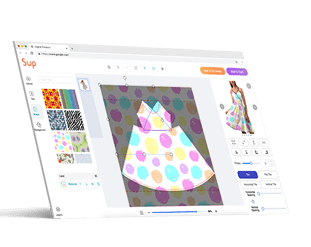How to Establish a Successful eCommerce Brand: 7 Easy Steps
The unstoppable rise of eCommerce is a double-edged sword for its current and aspiring merchants.
While there are certainly more consumers now who are comfortable buying online, the level of competition among online stores has also reached new heights, with data showing that there are currently over 26.5 million eCommerce stores operating worldwide.
This brings the question: how can you distinguish your eCommerce store from the endless sea of competitors?
Here at Sup Dropshipping, we know it’s all about establishing a successful eCommerce brand that’s reliable, easily recognizable, and trustworthy.
This article houses all the keys to unlocking the branding potential of your eCommerce business, so don’t miss out!
Why eCommerce branding is important

One of the worst rookie mistakes you can ever make is to bypass the “branding stage” of your eCommerce store. By doing so, you’ll be missing out on the huge perks brought by eCommerce branding, including these three advantages.
Makes your business memorable
eCommerce branding essentially creates a “face” for your business. It establishes a tangible visual that one may refer to as a personality, a front, or a vibe.
Long story short— branding helps your business stick in people’s minds.
Since people gravitate towards brands they recognize and feel comfortable with, being memorable is key if you want to survive in the world of eCommerce, where there are millions of businesses vying for attention,
Builds customer trust

When you buy a pair of jeans from your favorite brand, you pretty much already know what to expect, right?
Even without trying them on, you’ll likely think that the jeans will fit you exactly how you like them. As long as you choose the correct size, of course.
This expectation is only possible because you’ve come to trust the business, whether due to your own previous experience or by reading other people’s reviews about the brand. In other words, the brand has already built a certain level of reliability surrounding its name.
If you also want to establish trust between your customers and your business, branding is the ultimate key.
By creating a strong eCommerce brand, you’re basically saying that:
“Hey, every time you see our name or logo on a product, rest assured that we’ll deliver as promised!”
So, even if you offer new product lineups, most of your customers won’t be skeptical about the quality of your new items simply because your brand itself is your proof of credibility.
Moreover, customers can rest assured that if anything goes sideways, customer support will wait for them, as always.
Improves advertising campaigns
Ever noticed how some ads just scream the brand’s vibe even a mile away?
Take Adidas, for instance. All their advertising campaigns are all about the “never give up” and “pushing boundaries” theme.
This uniformity in style allows Adidas to show who it is as a brand and makes the process of coming up with new marketing campaigns way easier for the company.
After all, instead of starting from scratch, for example, they simply need to come up with ideas that suit their brand’s already-established marketing style.
Branding, once again, saves the day by making your brand’s advertisement memorable.
7 Simple Steps to Create a Strong eCommerce Brand
Already convinced that branding is necessary for your business? Then, without further delay, let me share the exact steps you can take to create your eCommerce brand!
1. Focus on a specific niche

With the global reach of eCommerce businesses, it can be very tempting to try to make everyone your brand’s loyal customer.
But before you even have any idea about what your brand is going to be about, you should choose a specific niche or industry you want to focus on.
The rule of thumb is the narrower your focus, the easier it’ll be to acquire customers, advertise your brand, and eventually scale up.
Take Tesla, for example. It’s a very big brand known for having a niche that focuses on electric cars and renewable energy resources. So, when people need products related to either of these, Tesla is definitely one of the brands they’re considering.
Now, here comes the big question:
How do you actually find your niche?
Well, you can get dozens of different answers depending on who you ask. But I like to keep it simple by telling our clients that they should find an industry that meets all these three criteria:
- Aligns with your interests or passion
- In high demand and has a substantial market size
- Pursuable using your current resources
Editor’s pick: Secrets on Target Audience: How to Know and Keep Them in Your Business
2. Define your Unique Selling Proposition (USP)
If you’ve taken any business-related course before, you may have already heard of the term Unique Selling Proposition (USP).
Simply speaking, this refers to a statement that summarizes what makes a brand unique from its competitors. Think of it as your special ingredient or your secret sauce that makes your brand stand out in a crowded market.
The best way to truly understand USPs is to use real-world examples, so let’s use the USPs of three brands that are almost impossible not to know:
- Canva: “Empowering the world to design”
- Best Buy: “Find a lower price, and we’ll match it”
- FedEx: “When it absolutely, positively has to be there overnight”
Clearly, all of these USPs show exactly why customers should choose or buy from their brand.
As an aspiring eCommerce brand owner, you should also come up with a Unique Selling Proposition just as strong as the examples above.
Highlight the best thing or things that set you apart from your competitors. Whether it’s your unmatched quality, your lightning-speed shipping, or it could even be as simple as your packaging.
Your store’s USP will act as the primary guideline as you continue to build your brand.
Heads up: Finding your USP might take a little brainstorming, but hey, take your time and have fun with it! Try out different things until you find what makes your brand really shine.
3. Know your brand’s story
The best way for people to connect with others is to connect emotionally. But did you know this also applies to brands who want to reach their target market?
When people can empathize with your brand, its roots, values, and missions, they’ll have more reason to support your store than competitors that just exist without hinting out when or why they even started.
That said, at this point, take a moment to think about the “WHY” behind your business.
Answer these questions in your head:
- Why did you start this venture?
- What inspires you to continue selling products?
- What problem are you passionate about solving?
- How do you choose and source products to sell?
- What do you wish to offer to your target market?
Your brand story will be the heart and soul of your business that’ll connect with customers on a deeper level. Make sure it’s authentic, relevant to your niche, relatable, and can build trust and loyalty.
Once you have a clear understanding of your brand’s story, don’t forget to include an “About Us” section in your eCommerce store later so you can formally introduce “who” your brand is to customers.
Moreover, use the brand story as inspiration in creating your store’s unique brand identity, which we’ll tackle in detail later.
4. Spy on your competitors

To know what you’re up against in the eCommerce world, you must constantly spy on your competitors within your niche to always have the upper hand in the competition.
Every successful eCommerce business implements this strategy, so there’s no need to feel sneaky about repeatedly peeking at what other brands are up to.
Think of this step as market research while channeling your inner Sherlock Holmes.
By spying on your competitors, you can learn a lot about what’s working (and what’s not) in your niche. Maybe other stores have a killer marketing strategy from which you could get inspiration, or perhaps there’s a gap in the market that the majority of merchants have overlooked.
Keep in mind that there are multiple ways to spy on your competitors.
Of course, there’s the classic route of manually checking the websites, social media feeds, and customer reviews of competitors you are wary of.
However, the most efficient way to spy on your competitors is to use eCommerce spy tools that consolidate large amounts of data from your competition into manageable information that can directly help you improve your brand.
Once you have a better idea of exactly what works and what doesn’t in your niche after spying on your competitors, it’s time to…
5. Create a unique brand identity
You finally reached the fun part of branding! Basically, this step is where you craft your brand’s unique visual identity by carefully designing a logo and choosing an overall aesthetic for your brand.
To accomplish this step, you should take inspiration from your brand’s name and story while making sure you don’t come up with visuals that are too similar to the competitors you’ve spied on earlier.
All the branding elements I’ll mention below are crucial in representing your brand, so make sure every decision is carefully considered.
Color palette
To start, choose a color palette that speaks about your brand’s personality and values.
Whether it’s bold and vibrant or soft and serene, the color palette will set the tone for everything else in the branding stage.
I highly recommend learning a little about color psychology when coming up with a color palette for your store because, often, colors evoke specific emotions.
Logo

Your logo is your brand’s visual signature. Since it’s the first thing people see and remember about your store, it should represent your brand’s personality as much as possible.
When designing logos, you wanna keep it simple, memorable, and versatile while still capturing the essence of your brand.
Just think of Nike, Adidas, and Apple’s logo, for example. These brands undeniably have some of the best logos out there, but even just at the top of your head, you can most likely roughly sketch their logos.
Pro tip: I highly recommend hiring professional designers to create your logo, especially if you don’t have much experience in graphic design. Not only can they help you with the actual design, but they can also ensure that the digital files you use are suitable for different platforms.
Other visual elements
Of course, don’t forget to also plan for other visual elements that can further elevate your store’s branding.
Apart from the logo and the colors you use, think about the fonts that represent your store best, along with patterns and icons that you may also want to integrate into your branding.
These details may be subtle, but they can truly amplify your brand’s personality.
Once again, you can always ask professional designers to help bring your brand identity to life.
Related reading: Branded Dropshipping: Comprehensive Guidance
6. Implement your store’s brand identity

Let’s start this brand identity implementation step by first focusing on the biggest representative of your brand: the products you sell.
Now, I’ve written an entire article about how to find profitable products for your business, so I won’t dive into that process too much.
But in relation to branding, here’s what you need to remember when sourcing products:
The products you sell must always be reflective of your brand, its story, and its values.
You can’t just say, “Oh, my brand story is about being sustainable and helping the environment,” and then proceed to use one-time-use products like plastic straws.
Once you’ve ensured your products align with your brand identity, it’s time to incorporate your brand’s visuals into your virtual storefront.
Start by integrating your logo, brand’s colors, and other visual elements throughout your store design. Just imagine this step as the virtual version of renovating a physical store by repainting its walls, adding a color accent, and choosing furniture.
Of course, apart from the store itself, your brand’s visual elements should also be present in your advertising campaigns, product packaging, and social media presence. Everything that involves your store should always have some form of brand consistency.
Make sure your brand shines in every part of the customer experience, from the moment they click on your website until their checkout!
7. Maintain brand reputation
Wanna know how big brands manage to maintain their stellar reputation over the years?
It’s because they always deliver their promises.
Whether it’s about the quality of your product, how fast you ship them out, or how you handle hiccups along the way, make sure you meet customer expectations.
Pay attention to what your customers are saying and be quick to respond with a friendly ear and a helping hand. Even if you’re facing some negative backlash, show them that you’re ready to make things right.
Last but not least, go the extra mile to keep your customers smiling.
You can throw in a little gift with their orders, giving them a heads up about your new product, or just send them a friendly note to say thanks.
Read next: How to Open an Online Store: 9 Easy Steps + Mistakes to Avoid
Let Sup Dropshipping help build your eCommerce brand
The best way to protect the image of your brand is to ensure that every product you sell aligns perfectly with your store’s promise, branding, and goals.
To achieve this, you’ll want to work with a supplier who not only provides your store with high-quality products but also has the resources to offer extra services such as customized packaging, top-notch customer service, and free business advice!
Still on the hunt for an all-in-one trusted supplier like this? Just contact Sup Dropshipping.
Through our app and dropshipping agents, you’ll have all the resources necessary to create a strong eCommerce brand that excels in the market.
About the Author

Jack Han
Jack is a SEO manager and blog writer at Sup Dropshipping. He holds an MA in Linguistics and Education. He has over 10 years experience in E-commerce, and 5 years of experience in SEO. Jack is an enthusiast to share his recent knowledge learnt from peer experts in the industry.





Leave a Reply